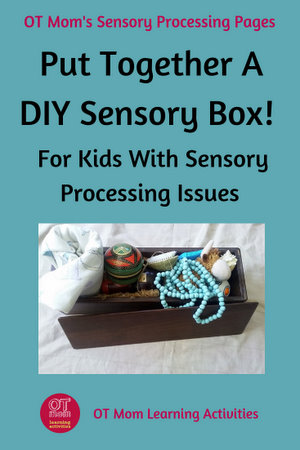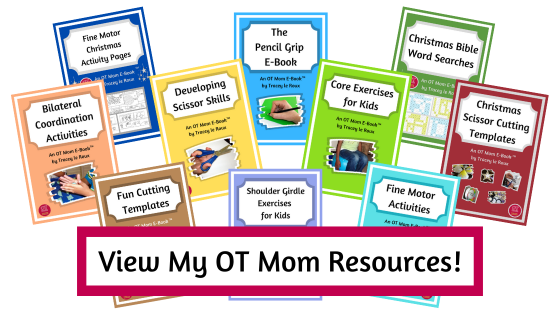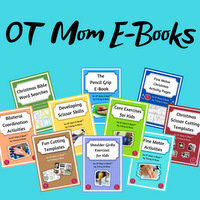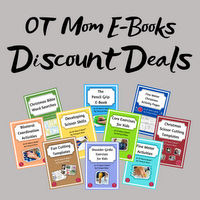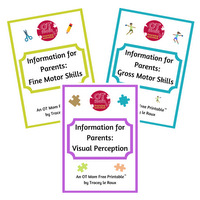- Home Page
- Sensory Processing
- Sensory Integration Activities
- Make A Sensory Box
Make A Sensory Box
A sensory box contains a variety of objects to touch and fiddle with, that could help your child manage their sensory integration and processing. This can be a very helpful resource for a child who has sensory processing differences.
- If your child tends to get over-stimulated easily, then the box could contain objects that could help your child to calm down and modulate their over-aroused state.
- If your child tends to be lethargic and under-responsive, then the box could contain objects that could help stimulate the senses to be more alert and help your child to focus on listening or thinking.
- If your child tends to be sensory seeking, then the box could contain objects that could provide sensory stimulation in a way that is acceptable for the situation - such as being able to sit and listen to a story while fiddling with an object from the sensory box instead of bouncing on the furniture!
I sometimes link to products (#Ad) that are similar to those I use and love. If you do purchase something through my links, I will receive a small commission that helps support my site - thank you!
- How to make a DIY sensory box
- Tactile items for the box
- Fiddly items that work well
- Sensory resources to look out for
NB if you are looking for a touch-and-feel type box where kids learn to identify things with their hands, then my page of tactile discrimination activities should give you what you are looking for!
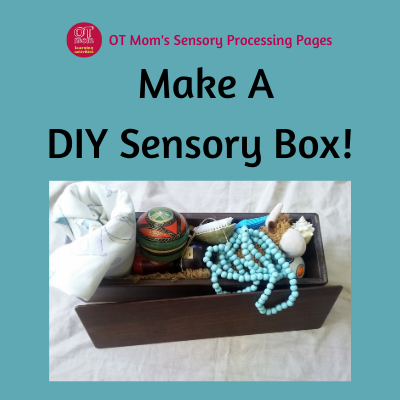
For your convenience, I have linked to products on Amazon (marked #Ad) that are similar to the ones I use myself - I may receive a small commission if you purchase something through these links, which helps support this site. However, you are under no obligation to purchase anything!
How To Make A Sensory Box
You can make your DIY sensory box fit your budget, and make use of the resources you already have on hand at home.
There is no standard recipe or instructions for putting together a sensory box - you will need to discover what your child responds well to by observing your child, talking with your child, and getting feedback from therapists and teachers who are involved with your child.
 Ready to explore the box!
Ready to explore the box!Many sensory boxes on the market contain mostly plastic items, which is why I feel that a DIY box with a variety of household objects can be more helpful as you can incorporate a variety of textures and weights.
Where and when to use your sensory box: You can keep your box in a quiet corner of your house (a sensory corner), where your child can go to "unwind" , calm down or get focused. You can also keep one or two items on hand in your reading corner, where your child can use the item to stay focused while listening to you read aloud.
Sensory Boxes are also great developmental resources for babies and toddlers, keeping them busy for ages while they explore all the items - please make sure you use age-appropriate items that are safe for them to put in their mouths!
Important - always consider the age of your child and their developmental stage - avoid objects that could be a choking hazard for your child. Also avoid objects that break easily or have sharp edges.
Tactile Items
Look for items that have various textures. Some children find it soothing to hold or play with something soft and fluffy, while others find rougher textures more pleasing.
Rougher textures can also provide great tactile input for sensory seeking kids.
You may find that your child enjoys stroking an item, or rubbing it on the hands, arms and face.
Here are some tactile objects that I find helpful (as shown in the photo):
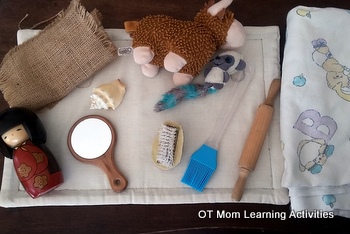 Tactile items for a sensory box
Tactile items for a sensory box- Smooth wooden objects (wooden doll, toy rolling pin and wooden mirror) - these are heavier than plastic objects, and smooth wood is warm and soothing to the touch.
- Rough textured material (hessian, corduroy, textured soft toy) - running your fingers or hands over rough fabric can be helpful.
- Soft textured material (fluffy soft toy, baby blanket) - there is a good sensory reason why most baby soft toys are soft and velvety!
- "prickly" objects (nailbrush and sea-shell) - as with with the textured material, prickly objects can help a sensory seeking child focus. You can even try velcro - some teachers put velcro patches (the rough side) under a child's desk to give the child something to rub the fingers on while listening in class!
- The silicone pastry brush is an odd addition, but some of my kids enjoyed brushing the soft bristles over their hands and arms!
Fiddly Items
These items are helpful in that they can provide some proprioceptive input to help calm an over stimulated child, or they can provide the necessary stimulation needed to help a sensory seeking child to focus during a listening activity.
Here are some fiddly objects that I find helpful (as shown in the photo):
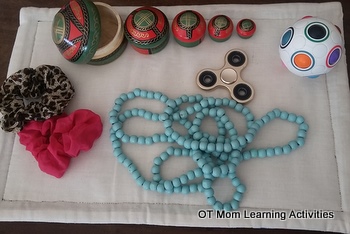 Fiddly items for a sensory box
Fiddly items for a sensory box- Beaded necklaces (especially wooden beads) - warm and smooth to hold, it is soothing to let them slip through your fingers.
- Wooden nesting toys#Ad - take the nesting pieces apart and put them together again.
- Fidget spinners - look for metal ones that are a bit heavier than plastic ones. Spinning them is soothing to watch, as well as fiddly. Personally, I prefer these flippy chains#Ad - much quieter and still satisfying.
- Hair "scrunchies" - the elastic is safely encased in fabric, so you child can stretch, pull and twist the elastic to his/her heart's content.
- Puzzle balls#Ad - these require the child to push the
little balls into place, which works the hand muscles, giving
proprioceptive feedback. However, the clicking noise may drive some parents a little nuts while it calms their child!
Sensory Box Resources
You should be able to find a variety of tactile, wooden or fiddly items at home or at a yard sale - but here are a few additional items that can make great gifts for kids who struggle with sensory processing issues.
- Tom's Flippy Fidget Chains (#Ad) are my family's own choice of fidget toys - this brand is the best quality, and are a great, small toy to keep in your handbag or in your pocket to haul out when your child needs something to fiddle with. These are definitely the quietest fidgets, and very effective!
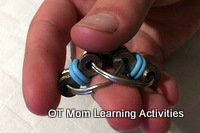 Tom's Flippy Fidget
Tom's Flippy Fidget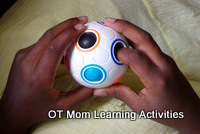 Fidget Puzzle Ball
Fidget Puzzle Ball- Wooden Busy Boards#Ad, or Wooden Busy Cubes#Ad, are great additions to any large sensory box or sensory corner. Just be sure to choose wisely - some have rather noisy attachments, so be sure to choose one that does not make a noise which drives you crazy... ask me how I know!
- These fidget puzzle balls (#Ad) are also great to put into the sensory box. The clicking noise as the pieces pop into place may be a bit annoying for some parents, but most kids I know have really enjoyed this.
Once you find out which items work best for your child, consider
putting one into your handbag and into your child's pocket, so that you always
have something at hand to help modulate any sensory issues.
Thank you for visiting! I hope you found this page helpful and were inspired to help your child with sensory processing issues!
Why not sign up for my occasional newsletter to stay in touch with new pages on my site?
You may find some of my other sensory processing pages helpful:
- Home Page
- Sensory Processing
- Sensory Integration Activities
- Make A Sensory Box
Share this page to help others!
Didn't find what you were looking for? Try a search of my site!
